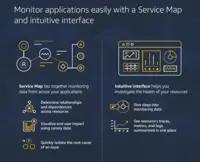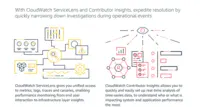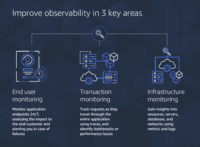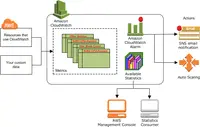Overview
What is Amazon CloudWatch?
Amazon CloudWatch is a native AWS monitoring tool for AWS programs. It provides data collection and resource monitoring capabilities.
Best monitoring tool for instances
A multipurpose tool for cloud services users, best for monitoring all the cloud resources
Amazon CloudWatch Review
CloudWatch - Excellent Service to Monitor Cloud Applications
AWS CloudWatch - an easy to use monitoring tool for your AWS instances and resources
Best Choice For Your AWS Structure
CloudWatch by a Simple Engineer
Watching the AWS Cloud is easier with CloudWatch
CloudWatch provides the basics, but you may need more.
You will enjoy using AWS CloudWatch
Metrics made easy
A cloud service offering monitoring with integration features for cost and scalability
AWS CloudWatch is the foundation for your AWS Security Automation
A must-have!
Pricing
Canaries
$0.0012
Logs - Analyze (Logs Insights queries)
$0.005
Over 1,000,000 Metrics
$0.02
Entry-level set up fee?
- No setup fee
Offerings
- Free Trial
- Free/Freemium Version
- Premium Consulting/Integration Services
Product Demos
AWS Container Day - Amazon Cloudwatch (Container Insights)
Product Details
- About
- Competitors
- Tech Details
- Downloadables
- FAQs
What is Amazon CloudWatch?
Amazon CloudWatch Screenshots
Amazon CloudWatch Videos
Amazon CloudWatch Competitors
- Datadog
- Azure Monitor
- Splunk IT Essentials
- New Relic
- AppDynamics
- Dynatrace
- Oracle Cloud Infrastructure (OCI)
Amazon CloudWatch Technical Details
| Deployment Types | On-premise |
|---|---|
| Operating Systems | Windows, Linux, Mac |
| Mobile Application | No |
| Supported Countries | Americas, Europe, Middle East, Africa, Asia Pacific |
Amazon CloudWatch Downloadables
Frequently Asked Questions
Comparisons
Compare with
Reviews and Ratings
(167)Attribute Ratings
Reviews
(1-25 of 25)Best monitoring tool for instances
- EC2 instances are easy to integrate into a system
- Simple to use
- Need improvement on dashboards
- Improve altering regarding unusual IP addresses
A multipurpose tool for cloud services users, best for monitoring all the cloud resources
- Provides various metrics for cloud resources
- Logging functionality across all the cloud resources.
- Ability to trigger events on exceptions or any user-defined actions.
- AWS Lambda CloudWatch logs become a little tricky to analyze when used in multiple threads.
- Searching on CloudWatch is slow if we apply multiple text filters.
Amazon CloudWatch Review
- Alarms on disk and thresholds for CPU and all vitals on ec2 systems.
- Billing and cost metric for advisor alerts to manage bills.
- DNS alerting for and critical issues with resolution to any of our sites.
- Possible better visual graphs are basic.
- More exports of the data types.
- Easier topics for initial setup to alams data.
- Easy to use
- Easy to integrate to a system based on AWS EC2 instances and other AWS resources
- Can trigger alerts
- Integration with non-AWS applications
- Not really online, there's a short delay
- Need to improve in monitoring and alerting about irregular IP address/requests
Best Choice For Your AWS Structure
- Stability and availability
- Easy usage
- Integration with other AWS Resources
- Price is higher than other 3rd party monitoring tools and log shipping tools.
- You can see 5-minute log intervals with standard monitoring.
CloudWatch by a Simple Engineer
- Gives a well-reported status on your system health, usages, and traffic.
- The ability to place monitors on any or all of our instances while triggering alarms on certain events.
- Easy to set up and create alarms.
- The interface is really well designed.
- Its limitation on only Amazon resources.
- Cost is higher.
- Lack of ability to create graphs on distinct counts and histograms which can make it hard quickly identify specific IP addresses that have a high request volume in a certain period. We have worked around this but a feature on the dashboard would be nice.
It is great for scalability/cost. We know when to increase an EC2 instance or when it can be scaled down. I do have a concern on the documentation. I would say it is not for AWS beginners and to actually talk to support can be costly.
Watching the AWS Cloud is easier with CloudWatch
- Monitoring of AWS resources
- Aggregation of low-level infrastructure metrics on the cloud
- Providing alerts on given events on AWS infrastructure
- Easy integration in to anything deployed on AWS
- Better integration with applications that do not use core AWS services
- Better customization of log metrics
- Better reporting with fewer reporting errors
CloudWatch provides the basics, but you may need more.
- Monitoring application state - up/down/stressed.
- View of API calls - threshold, volumes, response times.
- Rules-based functionality to allow for automatic triggering of Lambda functionality.
- CloudWatch doesn't monitor things outside of the cloud, it's not what it is intended for.
- Billing is confusing as it bills on Dashboard, metrics called, custom metrics, etc. Hard to forecast the charge.
- Paradigm is confusing sometimes and difficult to learn.
You will enjoy using AWS CloudWatch
- Easy to use
- Alarms available
- A little bit expensive
A cloud service offering monitoring with integration features for cost and scalability
- Monitor physical resources for EC2 instances.
- You can integrate AWS Cloud Watch with EC2 Autoscaling service to create new instances.
- You can notify any anomaly detected via Amazon SNS.
- AWS can include User Experience monitoring for applications hosted on AWS.
- AWS can include code-level traceability for transactions on monitored technologies.
- CloudWatch could be deployable to other on-premise services from customers.
A must-have!
- The rules section is just awesome. You can schedule events with CRON schedules.
- You can keep on track all your AWS services in just one program. The ability to create all types of dashboards for your services is great.
- Very easy to use, set alarms so easily and quick, one of the best things since anyone can create these without having so much advanced IT knowledge.
- To be honest, in my case, there's not too many things that I would need this program to improve since we can do everything we need so far.
Easy to implement & cost effective
- CloudWatch API allows integration into multiple monitoring solutions, such as SolarWinds Orion, Site24x7, and Grafana just to name a few we use.
- It's cost-effective and you only pay for what you use.
- Easy implementation, just a few lines which you can rinse and repeat when provisioning workloads from code or a few tick boxes when doing ad-hoc.
- Memory metrics on EC2 are not available on CloudWatch. Depending on workloads if we need visibility on memory metrics we use Solarwinds Orion with the agent installed. For scalable workloads, this involves customization of images being used.
- Visualization out of the box. But this can easily be addressed with other solutions such as Grafana.
- By design, this is only used for AWS workloads so depending on your environment cannot be used as an all in one solution for your monitoring.
Amazon CloudWatch Review
- Logs
- Metrics
- Alerts
- The dashboard needs some improvements to read.
Best monitoring application offered by Amazon
- Amazon Cloudwatch integrates with all the Amazon deployment infrastructure and provides monitoring capabilities at each step of the pipeline.
- Individual dashboards can be configured to do performance monitoring.
- Alerts can be configured for different performance indicators that can be very useful for event mitigation.
- Presently the application expects scripting experience in order to configure individual scripts for handling performance monitoring and alerts.
- The documentation is not at par for an enterprise offering and hence it makes the learning curve even steeper.
- CloudWatch integrates flawlessly with any AWS object like load balancers, EC2 instances, target groups, etc.
- CloudWatch is extremely easy to create graphs and charts with.
- Creating Dashboards on CloudWatch is as simple as dragging and dropping selected charts.
- It is not always easy to understand what metric type one should use with CloudWatch metrics. Averages, sums, min, max, etc. are not always readily apparent and CloudWatch does not stop you from creating useless metrics.
- CloudWatch cannot show milliseconds, it will instead show numbers in 'e' notation.
- Many of the standard metrics provided by AWS into cloudwatch cannot see below 1 minute intervals.
CloudWatch for the win
- We are able to capture all of our Lambda logs through CloudWatch and ship them off to another provider for analysis.
- The alerting features allow us to scale certain services when needed so we don't have to do it manually, or over provision.
- Monitoring resource utilization allows us to see what is going on in our RDS services, so we can test optimizations and fixes.
- The auto refresh feature could use some work so that it doesn't kick you back to the main dashboard.
- The search features aren't as well developed as other areas in the AWS console.
- It would be nice to be able to create a custom dashboard of multiple widgets like resource stats and alarms on one page.
Amazon CloudWatch logs allowed us to stream massive amounts of logs off of devices without hitting any throttling, and then to stream those into S3 or ELK as needed for analysis.
AWS CloudWatch: a must for your cloud AWS infrastructure
- We use CloudWatch for collecting and monitoring logs for the AWS infrastructure.
- CloudWatch events and alarms are configured for all our infrastructure running on AWS. Like Ec2, ECS, AWS Lambda, RDS. We can track auto-scaling at the service level (ECS) and instance level (EC2 and ECS).
- CloudWatch helps collects monitoring data in the form of logs and events and provides one unified view of AWS resources and services that run on AWS.
- We use it for monitoring logs and events, raising alarms if our infrastructure has any issues and also CloudWatch logs into ELK system for detailed log analysis and monitoring.
- AWS Lambda's cold and warm boot times can also be registered using it.
- CloudWatch could provide better log analytics using a better log parsing and log indexing. Like what is provided in ELK or Splunk.
- Better dashboarding can be provided. Currently the dashboarding is very rudimentary.
- No good customizable log indexing is available.
- Allows integration into non-native products (SolarWinds, Nagios, etc).
- Proactive monitoring and recommendations.
- Alerting and dashboards.
- There is only a limited amount of credits available each month when pulling metrics into other applications. We have had to use larger polling intervals as a result.
- Unable to export alert data into 3rd party data warehouses for record keeping.
- Learning curve is slightly steep and there isn't much automation in terms of setting alerts up.
Simple Log Aggregation and Metrics Out-of-the-Box
- Integration with other AWS products is CloudWatch's greatest feature. CloudWatch logs and metrics are provided out-of-the-box for ECS, Lambda, Sagemaker, and most other AWS products. Log aggregation and instrumentation are difficult to configure and manage; it is great to defer that work to AWS.
- Configuring log retention policies is simple with AWS. If your business is required to retain logs for years, being able to automatically move old logs to S3 IA or Glacier with a few clicks is convenient.
- Configuring alerts from metrics is simple, and it is easy to integrate alerts with PagerDuty or email.
- The console's log search lacks many of the features you would find in PaperTrail or Log.ly. Regex search is either not supported, or very difficult to find.
- It can be difficult to understand how the CloudWatch bill breaks down by log group.
- The date/time picker in the console could be easier to use.
Don't Skip Proactive Server(less)-side Monitoring
- Lambda process monitoring, particularly useful when you're relying on third-party services.
- Active monitoring RDS (set thresholds so we know before a database runs out of space)
- Auto-requisitioning of additional resources
- Your organization is married to the AWS ecosystem
- You tech stack is reliant on third-party services
- You use Splunk as your log aggregator (integrates well)
- You prefer to be proactive about health of your tech stack
- You don't use AWS
- You like to fly by the seat of your pants
CloudWatch - Flexible Log Management At A Great Price Point
- Managing log retention periods is very simple with CloudWatch, and can be configured on a per-group basis.
- Monitoring host performance is very easy when coupled with the CloudWatch Agent on an EC2 instance. A simple installation and configuration replaces an entire 3rd-party host monitoring stack.
- CloudWatch is flexible enough for not just host monitoring, but application monitoring as well. It's easy to pipe local logs up to CloudWatch and extract structured data in order to monitor and set alerts on custom app metrics.
- Unfortunately, the CloudWatch dashboard does not provide the ability to create histograms of discrete counts. This makes it difficult to, for instance, use CloudWatch to quickly identify specific IP addresses that have a high request volume in a certain period.
- The UX for creating a custom metric from a CloudWatch log group is somewhat confusing. Every time I need to create a new metric I find myself fumbling around the interface for a few minutes while I try to remember how to do it.
- The alerting options for CloudWatch are not as extensive as are available with some 3rd-party services.
A great tool to get insights into your AWS infrastructure.
- Monitor
- Alert
- Visibility
- Amazon-only
- cumbersome compared to other solutions
- not 100% customizable.
- Infrastructure monitoring
- Infrastructure alerting
- Dashboarding
- Building cloudwatch dashboards can be cumbersome. You have to navigate through various screens to get the metrics you want to add.
- Exporting alarm / alerting data is not available for further post-processing or analysis
- You have to build alerts and alarms yourself. CloudWatch does not give you any recommendations, so you have to know what you're doing.
Easy to set up
- Easy to set up
- Pay per use
- Better performance
- IPv6 support
- No free support
Amazon CloudWatch is an essential tool for governing your system-wide resources and app management
At my organization, we use AWS (Amazon Web Services) to spin up new server instances for any business critical applications we require. This is known as containerization. Instead of purchasing new computers we buy more RAM and then have the capacity to spin up or shut down an almost limitless array of servers on an as-needed basis.
Not long ago companies needed to physically install servers on-site. Hardware would need to be upgraded, administrated and repaired. Also if these servers contained sensitive data, they would need to be secured from hacking or fire and theft.
Today we let Amazon host all of our data in the cloud. They are at least partially responsible for guarding our data from theft and fire. Our organization instantly recognized the benefit of being able to administrate our AWS server instances via Amazon CloudWatch. If you rely on AWS in any way, you need to use Amazon CloudWatch.
- Application Performance Management.
- Error Management.
- Utilization Management.
- The interface is clunky.
- The context sensitive help could be written more clearly.
- I wish there were more options for arranging the dashboard interface to my specific needs.















